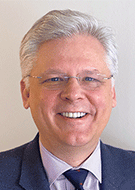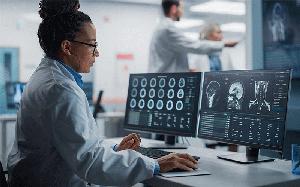Using rsfMRI to Head Into the Next Frontier of Radiology
Imaging can follow activity of brain network coactivation

When it comes to better understanding the inner workings of the brain, functional MRI (fMRI) has been nothing short of a gamechanger.
“We are all familiar with the anatomic changes seen at CT or MRI that occur in the brain over time,” said Andrei Holodny, MD, chief of neuroradiology at Memorial Sloan Kettering Cancer Center (MSKCC), New York City. “The advantage of functional MRI is that it allows one to delve much deeper into the inner workings of the brain.”
Dr. Holodny authored a commentary about a Radiology study on resting-state functional MRI (rsfMRI).
Most often used to identify specific areas of the brain in the preoperative brain tumor setting, fMRI involves having the patient perform specific tasks during the examination.
“For example, we ask a patient to think of words that start with the letter R, which kick starts the language areas of their brain—activity that we can see via fMRI,” Dr. Holodny explained.
Comparing the differences in brain activity, the radiologist can identify which part of the brain is associated with what function. With this information in hand, a neurosurgeon is better able to resect as much of the tumor as possible while protecting those parts associated with motor skills, language or visual tasks.
But what happens if the patient doesn’t speak English or if they are older, forgetful, hard of hearing or simply nervous about the procedure? For these patients, there’s rsfMRI.
As the name suggests, in rsfMRI the subject does not perform a task but instead ‘rests’ during the scan. The radiologist follows the spontaneous changes in MRI signal intensity over the duration of the examination for each parcellation of the brain. Those areas of the brain where signal intensity changes over time are synchronized and coalesce into functionally meaningful networks.
“By analyzing which areas of the brain coactivate, a physician can identify myriad neurologic networks from a single scan that lasts less than 10 minutes,” Dr. Holodny said.

From Preoperative to Cognitive
The challenge is moving rsfMRI into the realm of cognitive analysis, which is new territory for radiology.
“There’s some really exciting research happening right now that, although still in its infancy, is quickly moving the field in the right direction,” Dr. Holodny noted.
For example, the use of rsfMRI to study various brain networks has shown that these networks interact (correlate) and even occasionally compete with one another (anticorrelate). To illustrate, Dr. Holodny points to the interaction seen between the default mode network (DMN), which is thought to represent internal mindfulness, and the attentional network, which is thought to represent goal-directed external tasks. When the attentional network activates, the DMN deactivates, and vice versa.
The Radiology study on rsfMRI of healthy adults takes this one step further by looking at the how, when and where of brain network coactivation.
Using complicated mathematical analysis, researchers examined the coactivation patterns (CAPs) of various brain networks. Ultimately, they identified six different CAPs, where activation of one brain network reliably correlated or anticorrelated to another brain network.
The authors also found a reduction in the interactions between the frontoparietal network, which works to rapidly understand and execute new tasks, and the DMN, which focuses on internal mental-state processes like memory retrieval, with older age, possibly reflecting lower cognitive flexibility seen in normal aging.
“Results suggest that adults spend less time in the primary sensory network and frontoparietal network CAP with aging, further leading to a compensatory larger occurrence of the default mode network and attentional network CAP,” the authors write. “These findings provide insights into framewise aging-related network patterns and identify patterns that can serve as markers of brain disease and treatment targets of individualized neuromodulation.”
“Using rsfMRI, radiologists may be able to quantitate different types of depression, distinguish depression from dementia, and diagnose autism and ADHD. Although this is just scratching the surface in terms of what we’ll be able to do with rsfMRI, it’s all very exciting stuff.”
ANDREI HOLODNY, MD
A Transformative Opportunity for Radiology
According to Dr. Holodny, the advanced use of rsfMRI to understand cognition will be transformative for radiology.
“Using rsfMRI, radiologists may be able to quantitate different types of depression, distinguish depression from dementia and diagnose autism and ADHD,” he said. “Although this is just scratching the surface in terms of what we’ll be able to do with rsfMRI, it’s all very exciting stuff.”
While exciting, adopting this method will require radiologists to better understand which parts of the brain do what, how they interact in the normal setting and how these interactions change in pathological states.
“This is a huge opportunity for radiology to have an even bigger impact on patient care,” Dr. Holodny concluded. “But leveraging this opportunity requires that radiologists step up to the plate and start preparing today, because if we don’t, somebody else will.”
For More Information
Access the Radiology study, “Resting-State Functional MRI of Healthy Adults: Temporal Dynamic Brain Coactivation Patterns,” and the accompanying commentary.
Read previous RSNA News articles about neuroimaging:
- Developing Imaging Metrics to Personalize Brain Cancer Treatment
- Zero Echo-Time MRI Shows Diagnostic Efficacy Similar to CT
- New MRI Technique Detects MS Brain Changes Earlier